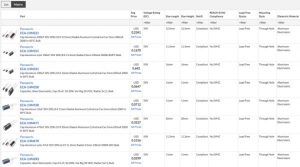When I was working on the capacitors section for the next version of Common Parts Library, I realized that it would be helpful to explain why one might pick one capacitor type over another. This information is important because there are a lot of factors (temperature characteristics, package, etc.) which might make a type of capacitor (electrolytic or ceramic) better than others for your project.
In this blog, we will explain all the different types of capacitors, their merits and demerits, and popular applications. We have included some recommendations for commonly used capacitor series with high supply chain availability from Common Parts Library and Seeed Studio’s Open Parts Library and linked to pre-created searches on Octopart, such as the following for 50V rated Panasonic’s ECA-1HM series for 10µF to 3300µF:
This is the first of a series of guides for passive selection: a deep-dive into selecting the correct capacitor for your project. Let’s dive into the world of capacitors:
Capacitors
Capacitors are two-terminal components used for filtering, energy storage, voltage spike suppression, and many other applications. In their simplest form, they consist of two parallel plates separated by an insulating material called a dielectric. Capacitors store electrical charge. The unit of capacitance is Farad (F), attributed to Michael Faraday who was a pioneer in using capacitors for practical applications. Capacitors can either be polarized or non-polarized. Polarized capacitors — nearly all electrolytic and tantalum capacitors — can only be connected one way in a circuit: if the “-” terminal goes above “+” terminal, it could lead to a short. Non-polarized capacitors — ceramic, mica, and film capacitors — can be connected either way in a circuit, so they are suitable for AC. Even though capacitors are so commonly used, it can be tricky to select one for your project. While you might know what capacitance or voltage rating your project requires, capacitors have lots of other characteristics — such as polarization, temperature coefficient, stability, equivalent series resistance (ESR) and so on — that might make them a great (or poor) choice for your project. The most popular types of capacitors are presented below with this in mind.
TYPES There are several different types of capacitors which differ by polarity, performance and cost. Below are some of the common capacitor types: aluminum electrolytic, ceramic, tantalum, film, mica and polymer capacitors, along with their characteristics, applications, package information as well as info on part selection.
Read more: How To Select A Capacitor

